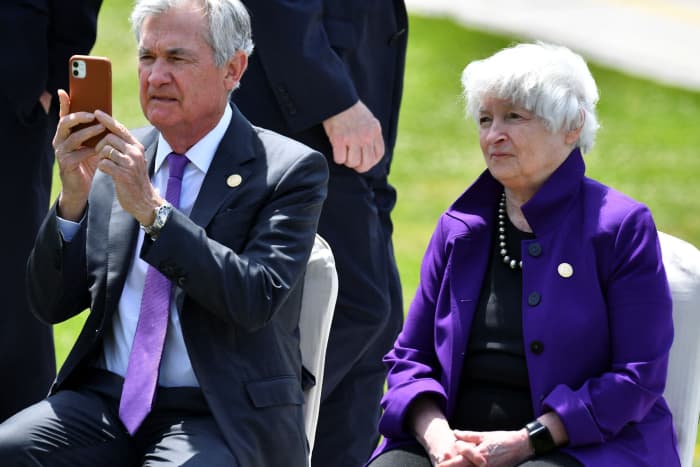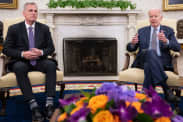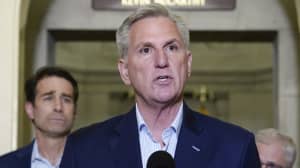While the spotlight is on House Republicans and the White House as they try to negotiate an increase in the U.S. debt ceiling, the Federal Reserve is in the wings.
If the talks collapse, and the government breaches the debt ceiling sometime in early June, the Fed will reluctantly move to center stage.
The central bank’s job would then be to try to mitigate the potential effect of a breach and the threat it would pose to the financial system. Fed officials have warned that they can’t work miracles and that the negative effects of any breach pose grave threats to the economy and the financial system.
“No one should assume the Fed can really protect the economy and the financial system,” Fed Chairman Jerome Powell warned earlier this month.
Financial market participants are showing some concern. A new study from the Brookings Institution said that investors in Treasury bills that are scheduled to mature in June are demanding a significant premium of 140 basis points to shoulder the risk of not being paid on time.
Stocks and the broader fixed-income market have so far remained relatively insulated, though sentiment soured this week as talks continue. The Dow Jones Industrial Average
DJIA,
See: ‘Doomsday machine’: Here’s what could happen if the debt ceiling is breached
The Fed wants to avoid putting its finger on the scale and seeming to favor the Biden White House or House Republicans.
John Canavan, bond strategist for Oxford Economics, said, “the Fed will do as little as they can get away with.”
“Any involvement will raise political questions from one group or another,” he added.
To get a sense of the script the Fed will follow, analysts lean heavily on transcripts of Fed discussions in 2011 and 2013 among top Fed officials about what they would do if the debt ceiling was breached
At the start of the 2013 meeting, then-Fed Chairman Ben Bernanke said he hoped the transcript “might be a potentially useful way to communicate some of our thinking to the markets in preparation for another episode, which, unfortunately, seems more likely than not to occur at some point.”
Here are possible answers to questions about the Fed’s likely playbook if there was a breach of the debt ceiling.
The Fed’s playbook
The U.S. government auctions securities each year
TMUBMUSD10Y,
If the debt ceiling is breached, principal payments on maturing securities could be funded by Treasury auctions. Old debt could simply be rolled into new debt. It is the interest payments that are a problem.
In 2013, Treasury and Fed officials developed a playbook. Under the plan, Treasury would give priority to interest payments on debt and delay payments on non-debt obligations. This plan is untested, and faces enormous obstacles but could work, Canavan said.
While Treasury Secretary Janet Yellen has repeatedly warned that the government could exhaust its ability to pay its bills as early as June 1, Canavan doesn’t see default as an immediate risk.
Treasury will get an influx of cash on June 15 from quarterly tax payments and that is when the first interest payment on the debt is due. Oxford Economics thinks the first real risk of a missed interest payment, or default, would be in late July.
The Fed will only act if the market becomes dislocated. If there is a flight to safety, the Fed may need to take steps to keep markets functioning through loan programs.
One worry is that there will be low levels of trading and high volatility. Cash may flow out of short-duration securities causing interest rates to rise.
In their past discussions, Fed officials felt that they could lend money to market participants though repo or reverse repo operations to keep the benchmark interest rate within the appropriate range. Fed officials also considered outright Treasury bill purchases if the bills market became overly impaired.
The Fed’s biggest worry and what they might do about it
The Fed’s biggest worry is that investors will step back from buying Treasury debt. In the most extreme scenario, this could result in a “failed auction” and the government would not have funds to pay off the maturing debt.
For instance, the U.S. could offer to sell $3 billion of 52-week Treasury bills, but see fixed-income investors bid to buy just $1.5 billion of the securities.
Failed auctions are not unheard of and have occurred in the UK and Germany since the turn of the century.
Derek Tang, an economist at LH Meyer Inc., said a failed auction would be “a very difficult situation” for the Fed.
Under the law, the Fed can’t step in and buy Treasurys directly at auction.
“So to minimize financial disruption, the Fed might be forced to set up a new short-term securities asset purchase program to put a floor under Treasurys and send a signal that the Fed stands ready as a buyer. That would raise confidence in the next auction but also complicate its ongoing asset sales program,” Tang said.
The market’s biggest worry and what the Fed might do about it
If the political gridlock only intensifies this summer, Treasury may ultimately have to delay interest payments on securities.
In 2013, market participants were most concerned that the Fed would accept defaulted securities as collateral or such debt could be purchased or swapped for new debt.
In response, Fed staff said continued use of securities with delayed payments would be appropriate, so long as it was clear that securities with delayed principal or interest payments would be valued at their potentially reduced market prices, under the assumption that the Treasury would make investors whole once the debt ceiling was raised.
When will the Fed communicate its playbook?
The market reaction to past debt limit crises was not always predictable and so it is not clear when is the best time for the Fed to communicate its playbook to the markets.
When the Fed communicates its plans is a “very complicated question,” Bernanke said in 2013. The central bank would not want to be seen as interfering in the negotiations.
But there is also some incentive to communicate.
Powell, who was a Fed governor, noted at the time: “If the real risk is of a failed auction, then saying something before it happens actually plays into whether it happens or not.”
During the discussion, Bernanke said, “It’s a very complicated question.”
“‘When is the appropriate time’ is a difficult one, and I think the best thing we could probably do, if possible, would be to try to coordinate with the Treasury and the announcements that it makes,” he added.
Will the Fed cut interest rates or end quantitative tightening?
“We’re not putting a lot of stock in the idea that the Fed will respond with rate cuts,” Tang said.
Instead, the Fed will hold its benchmark interest rate steady and focus on making loans to the markets.
The Fed will not want to adjust its quantitative tightening program because it is such an important part of its effort to show it is serious about rate hikes to battle inflation, Tang said.
In extremes, the Fed could follow the 2022 playbook of the Bank of England, which interrupted its quantitative tightening program for a few months to buy bonds to stem market turmoil after a disastrous rollout of the government’s fiscal plans.







